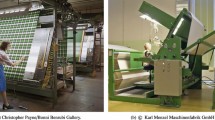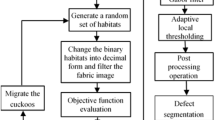Abstract
This paper addresses the problem of quality inspection of regular textured surfaces as, e.g., encountered in industrial woven fabrics. The motivation for developing a novel approach is to utilize the template matching principle for defect detection in a way that does not need any particular statistical, structural or spectral features to be calculated during the checking phase. It is shown that in this context template matching becomes both feasible and effective by exploiting the so-called discrepancy measure as fitness function, leading to a defect detection method that shows advantages in terms of easy configuration and low maintenance efforts.
Access this chapter
Tax calculation will be finalised at checkout
Purchases are for personal use only
Preview
Unable to display preview. Download preview PDF.
Similar content being viewed by others
References
Bay, H., Ess, A., Tuytelaars, T., Gool, L.V.: SURF: Speeded up robust features. Computer Vision and Image Understanding 110, 346–359 (2008)
Beck, J., Chen, W.W.L.: Irregularities of distribution. Cambridge University Press, New York (2009)
Bhattacharyya, A.: On a measure of divergence between two statistical populations defined by probability distributions. Bull. Calcutta Math. 35, 99–109 (1943)
Bodnarova, A., Bennamoun, M., Latham, S.: Optimal Gabor filters for textile flaw detection. Pattern Recognition 35, 2973–2991 (2002)
Bouchot, J.L., Stübl, G., Moser, B.: A template matching approach based on the discrepancy norm for defect detection on regularly textured surfaces. In: Proceedings of the SPIE 10th International Conference on Quality Control by Artificial Vision. SPIE, Saint Etienne (2011)
Broyden, C.G.: The convergence of a class of double-rank minimization algorithms 1. General considerations. IMA Journal of Applied Mathematics 6(1), 76–90 (1970)
Chen, C.M., Chen, C.C., Chen, C.C.: A comparison of texture features based on SVM and SOM. In: Proceedings of the 18th International Conference on Pattern Recognition, ICPR 2006, vol. 02, pp. 630–633. IEEE Computer Society, Washington, DC (2006)
Cheng, H.D., Sun, Y.: A hierarchical approach to color image segmentation using homogeneity. IEEE Transactions on Image Processing 9(12), 2071–2082 (2000)
Cohen, F., Fan, Z., Attali, S.: Automated inspection of textile fabrics using textural models. IEEE Transactions on Pattern Analysis and Machine Intelligence 13, 803–808 (1991)
Conci, A., Proença, C.B.: A fractal image analysis system for fabric inspection based on a box-counting method. Computer Networks and ISDN Systems 30, 1887–1895 (1998)
Drimbarean, A., Whelan, P.F.: Experiments in colour texture analysis. Pattern Recognition Letters 22(10), 1161–1167 (2001)
Fischler, M.A., Bolles, R.C.: Random sample consensus: a paradigm for model fitting with applications to image analysis and automated cartography. Communications of the ACM 24(6), 381–395 (1981)
Haralick, R.M., Shanmugam, K., Dinstein, I.: Textural features for image classification. IEEE Transactions on Systems, Man, and Cybernetics 3, 610–621 (1973)
Karoui, I., Fablet, R., Boucher, J.M., Pieczynski, W.: Fusion of textural statistics using a similarity measure: application to texture recognition and segmentation. Pattern Analysis and Applications 11(3-4), 425–434 (2008)
Kuipers, L., Niederreiter, H.: Uniform distribution of sequences. Dover Publications, New York (2005)
Kullback, S., Leibler, R.A.: On information and sufficiency. The Annals of Mathematical Statisitcs 22(1), 79–86 (1951)
Kumar, A.: Computer-vision-based fabric defect detection: A survey. IEEE Transactions on Industrial Electronics 55, 348–363 (2008)
Lizarraga-Morales, R.A., Sanchez-Yanez, R.E., Ayala-Ramirez, V.: Homogeneity Cues for Texel Size Estimation of Periodic and Near-Periodic Textures. In: Martínez-Trinidad, J.F., Carrasco-Ochoa, J.A., Ben-Youssef Brants, C., Hancock, E.R. (eds.) MCPR 2011. LNCS, vol. 6718, pp. 220–229. Springer, Heidelberg (2011)
Lowe, D.G.: Distinctive image features from scale-invariant keypoints. International Journal on Computer Vision 60, 91–110
Mirmehdi, M., Marik, R., Petrou, M., Kittler, J.: Iterative morphology for fault detection in stochastic textures. Electronic Letters 32, 443–444 (1996)
Monadjemi, A.: Towards efficient texture classification and abnormality detection. Ph.D. thesis, University of Bristol, UK (2004)
Moser, B.: Similarity measure for image and volumetric data based on Hermann Weyl’s discrepancy measure. IEEE Transactions on Pattern Analysis and Machine Intelligence 33(11), 2321–2329 (2011)
Moser, B., Stübl, G., Bouchot, J.-L.: On a Non-monotonicity Effect of Similarity Measures. In: Pelillo, M., Hancock, E.R. (eds.) SIMBAD 2011. LNCS, vol. 7005, pp. 46–60. Springer, Heidelberg (2011)
Murino, V., Bicego, M., Rossi, I.A.: Statistical classification of raw textile defects. In: 17th International Conference on Proceedings of the Pattern Recognition (ICPR 2004), vol. 4, pp. 311–314. IEEE Computer Society, Washington, DC (2004)
Ng, H.F.: Automatic thresholding for defect detection. Pattern Recognition Letters 27, 1644–1649 (2007)
Pietikäinen, M., Ojala, T.: Nonparametric texture analysis with simple spatial operator. Spectrum (1999)
Tolba, A.S., Khan, H.A., Mutawa, A.M., Alsaleem, S.M.: Decision fusion for visual inspection of textiles. Textile Research Journal 80 (2010)
Weyl, H.: Über die Gleichverteilung von Zahlen mod. Eins. Mathematische Annalen 77, 313–352 (1916)
Xie, X.: A review of recent advances in surface defect detection using texture analysis techniques. Electr. Letters on Computer Vision and Image Analysis 3, 1–22 (2008)
Xie, X., Mirmehdi, M.: TEXEMS: Texture exemplars for defect detection on random textured surfaces. IEEE Transactions on Pattern Analysis and Machine Intelligence 29, 1454–1464 (2007)
Author information
Authors and Affiliations
Editor information
Editors and Affiliations
Rights and permissions
Copyright information
© 2012 Springer-Verlag Berlin Heidelberg
About this paper
Cite this paper
Stübl, G., Bouchot, JL., Haslinger, P., Moser, B. (2012). Discrepancy Norm as Fitness Function for Defect Detection on Regularly Textured Surfaces. In: Pinz, A., Pock, T., Bischof, H., Leberl, F. (eds) Pattern Recognition. DAGM/OAGM 2012. Lecture Notes in Computer Science, vol 7476. Springer, Berlin, Heidelberg. https://doi.org/10.1007/978-3-642-32717-9_43
Download citation
DOI: https://doi.org/10.1007/978-3-642-32717-9_43
Publisher Name: Springer, Berlin, Heidelberg
Print ISBN: 978-3-642-32716-2
Online ISBN: 978-3-642-32717-9
eBook Packages: Computer ScienceComputer Science (R0)




